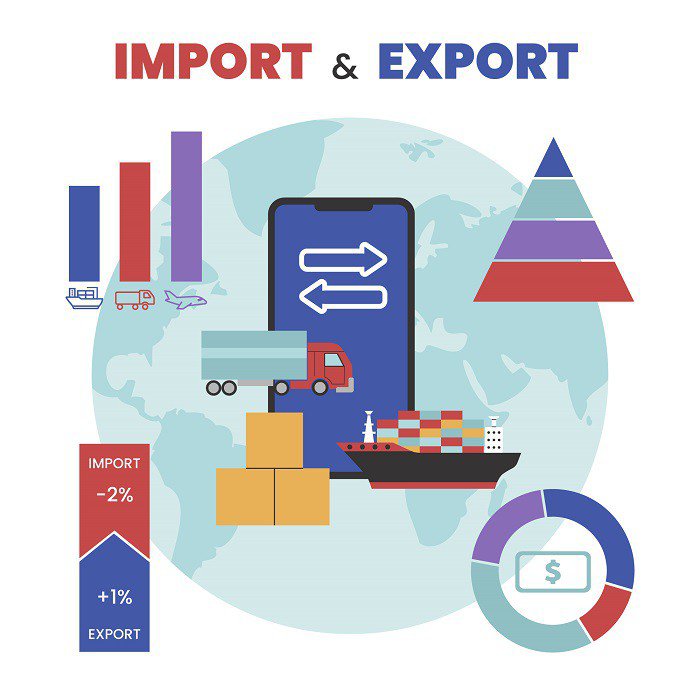
The United States significantly influences global trade dynamics due to its strong economy and vast geography. The foundation of the country's economic power is the smooth flow of cargo, which includes imports, exports, and transshipments. This complex network makes the efficient cross-border movement of goods possible by combining technological advancements, regulatory frameworks, and infrastructure strength. Understanding the volume of cargo being transported is essential; tools like a CBM Calculator can help businesses plan their logistics more effectively.
In this article, we examine the various facets of the cargo flow in the USA, looking at its import and export procedures and the role that transshipment plays in preserving the fluidity of the supply chain.
4 Facets of the Cargo Flow in the USA
Import Process
The process of bringing goods into the United States is organized into a series of steps that guarantee legal compliance while facilitating smooth cargo movement. An importer typically uses the Harmonized Tariff Schedule (HTS) to determine the classification and duty rate of the goods. This important step establishes the taxes and tariffs that will apply to imported goods.
The following step entails submitting the required paperwork to CBP (Customs and Border Protection) in the United States. The entry summary, commercial invoice, bill of lading, and other pertinent certificates or licenses are all included in this documentation. The Automated Commercial Environment (ACE) system, a cutting-edge technological platform that expedites the review process, allows for the electronic submission of these documents.
Then CBP evaluates the supporting documentation, confirms the declared value, and ensures adherence to trade laws. The imported goods are examined before release, allowing them to hit the domestic market. It is important to remember that some products might be subject to additional inspections, such as those on intellectual property rights protection or health and safety regulations.
Export Process
The export procedure requires adherence to laws in the United States and the destination nation, so it is equally meticulous. Exporters must first ascertain whether an export license is necessary for their products, particularly when dealing with sensitive technology or nations subject to trade embargoes. The Automated Export System (AES) of the U.S. Census Bureau enables exporters to submit export information electronically by governmental rules.
The commercial invoice, bill of lading, export license (if applicable), and any other certificates needed by the destination nation are included in the export documentation. These records help with compliance checks and customs clearance and facilitate the efficient movement of goods.
The goods are transported to the port of departure once they are prepared for export, and CBP inspects them there. This inspection ensures that the goods comply with export regulations and match the information in the documentation. The goods are checked before being loaded onto ships or aircraft for international transit.
Transshipment's Vital Role
Optimizing cargo flow depends heavily on transshipment, moving goods from one vessel to another while traveling. Due to its advantageous location and advanced transportation system, the United States is a significant transshipment hub. Major ports like Los Angeles, Long Beach, and New York serve as the offloading and reloading points for goods from large container ships as they travel to their ultimate destinations.
This method has several benefits, including more adaptable scheduling, cheaper transportation, and better connectivity to various international markets. Furthermore, transshipment hubs serve as consolidation points, enabling the consolidation of numerous smaller shipments into a single larger container to further improve transportation efficiency.
Challenges and Future Trends
Even though the cargo flow in the USA is well-established, it is difficult. The constantly changing environment of trade laws and tariffs is one major worry. The import and export processes can be impacted by changes in political dynamics or international agreements, necessitating a flexible approach from businesses and regulators alike.
The landscape of cargo flow is changing due to the quick development of technology. One way to improve transparency and security along the supply chain is to incorporate blockchain technology. Artificial intelligence and automation are also used to speed up cargo movement, reduce human error, and simplify documentation processes.
Sustainability and lowering transportation's carbon footprint have received more attention recently. As a result, the cargo sector is seeing a shift towards more environmentally friendly practices, including using cleaner fuels, optimizing shipping routes, and investigating alternative modes of transportation like rail and inland waterways.
Conclusion
The import, export, and transshipment processes that make up the cargo flow in the United States are orchestrated in a complex but well-coordinated ballet of legal compliance, technological advancement, and superior infrastructure. The country is positioned as a key player in global trade dynamics thanks to its advantageous geographic location, cutting-edge digital platforms, and extensive transportation infrastructure.
The United States is dedicated to preserving the effectiveness and resilience of its cargo flow to sustain its crucial role in the global economy as trade regulations change and technology continues to reshape the sector.





 Get instant quote
and compare offers in real time
Get instant quote
and compare offers in real time